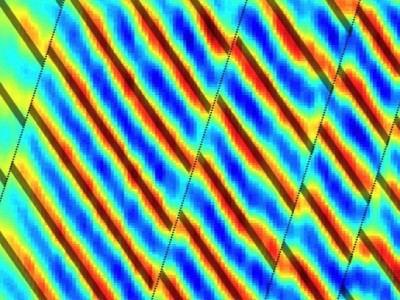
Particles known as fermions (illustration) can’t share the same state.Credit: Roman Andrade 3Dcienca/Science Photo Library
Theoretical physicists have proposed the existence of a new type of particle that doesn’t fit into the conventional classifications of fermions and bosons. Their ‘paraparticle’, described in Nature on 8 January1, is not the first to be suggested, but the detailed mathematical model characterizing it could lead to experiments in which it is created using a quantum computer. The research also suggests that undiscovered elementary paraparticles might exist in nature.
In a separate development published late last year in Science2, physicists experimentally demonstrated another kind of particle that is neither a boson nor a fermion — an ‘anyon’ — in a virtual one-dimensional universe for the first time. Anyons had previously been created only in 2D systems.
Because of their unusual behaviour, both paraparticles and anyons could one day play a part making quantum computers less error-prone.
Particle properties
Around the time when physicists began to understand the structure of atoms, a century ago, Austrian-born theorist Wolfgang Pauli suggested that no two electrons can occupy the same state — and that if two electrons are pushed close to being in the same state, a repulsive force arises between them. This ‘Pauli exclusion principle’ is crucial to the way electrons orbiting an atomic nucleus arrange themselves in shells, instead of all falling to the lowest possible energy state.
Pauli and others soon realized that this empirical rule of exclusion applied not only to electrons but to a broader class of particles, including protons and neutrons, which they called fermions. Conversely, particles that do like to share the same state — which include the photons in a laser beam, for example — became known as bosons. (Pauli and his collaborators also worked out why being a fermion or a boson appeared to relate to a particle’s intrinsic angular momentum, or ‘spin’.)
Welcome anyons! Physicists find best evidence yet for long-sought 2D structures
Mathematically, the fundamental property of fermions is that when two of them switch positions, the ‘wavefunction’ that represents their collective quantum state changes sign, meaning that it gets multiplied by –1. For bosons, the wavefunction remains unaltered. Early quantum theorists knew that, in principle, there could be other kinds of particle whose wavefunctions changed in more complicated ways when they swapped positions. In the 1970s, researchers discovered anyons, which can exist only in universes of one or two dimensions.
Zhiyuan Wang, now at the Max Planck Institute for Quantum Optics in Garching, Germany, and Kaden Hazzard at Rice University in Houston, Texas, have now constructed a model for paraparticles that can exist in any number of dimensions — and with properties that are different from those of either fermions or bosons. In particular, these paraparticles obey their own type of Pauli exclusion. “It’s not entirely surprising that it’s possible,” says Kasia Rejzner, a mathematical physicist at the University of York, UK. “But it’s still cool.”
Wang says he came up with the exotic swapping rules by chance in 2021, while doing his PhD. “It was the most exciting moment in my life,” he says. Wang adds that it should be possible — although challenging — to realize these paraparticle states on a quantum computer.



